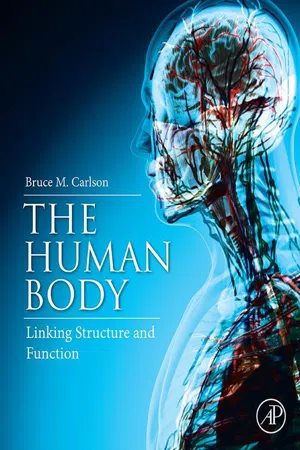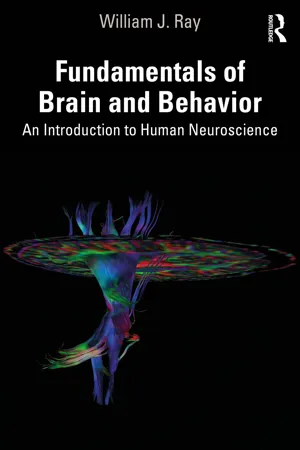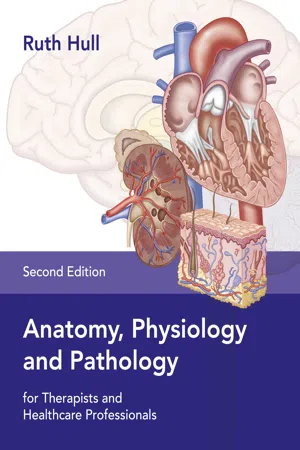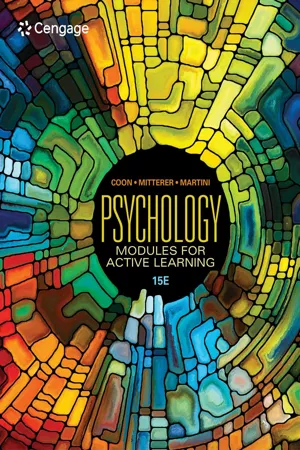Psychology
Nervous System
The nervous system is a complex network of nerves and cells that transmit signals between different parts of the body. It is responsible for coordinating and controlling bodily functions and processes, as well as responding to internal and external stimuli. The nervous system is divided into the central nervous system (CNS) and the peripheral nervous system (PNS), both of which play crucial roles in human behavior and experience.
Written by Perlego with AI-assistance
Related key terms
1 of 5
11 Key excerpts on "Nervous System"
- eBook - PDF
- Douglas Bernstein, , , (Authors)
- 2015(Publication Date)
- Cengage Learning EMEA(Publisher)
But the Nervous System can do far more than detect information and make responses. When information about the world reaches the brain, that information is processed —it is combined with information about past experiences and current wants and needs—to allow you to decide how to respond. Our exploration of the Nervous System begins at the “bottom,” with a description of its individual cells. Later we consider how these cells are organized to form the structures of the human Nervous System. biological psychology The psy-chological specialty focused on the physical and chemical changes that cause, and occur in response to, behavior and mental processes. Nervous System A complex com-bination of cells whose primary function is to allow an organism to gain information about what is go-ing on inside and outside the body and to respond appropriately. TRY THIS Copyright 2016 Cengage Learning. All Rights Reserved. May not be copied, scanned, or duplicated, in whole or in part. Due to electronic rights, some third party content may be suppressed from the eBook and/or eChapter(s). Editorial review has deemed that any suppressed content does not materially affect the overall learning experience. Cengage Learning reserves the right to remove additional content at any time if subsequent rights restrictions require it. 52 Biological Aspects of Psychology Neurons The Nervous System is an information-processing system with three functions: input, pro-cessing, and output (see Figure 3.1). These functions are possible partly because the Nervous System is made up of cells that communicate with each other. Two major types of cells, neurons and glial cells , allow the Nervous System to carry out its complex signaling tasks effi-ciently. The specialized cells that send and receive signals are called neurons , or nerve cells . Most of our discussion of brain cells concerns neurons, but glial cells are important, too. - eBook - ePub
The Human Body
Linking Structure and Function
- Bruce M. Carlson, Bruce M. Carlson(Authors)
- 2018(Publication Date)
- Academic Press(Publisher)
If any component of the body could take credit as its master controller, it would be the Nervous System. Its functions are sufficiently diverse and complex that entire textbooks and courses are devoted to it. Structurally, the brain and spinal cord, at first glance, seem to be almost featureless, with the consistency of a thick pudding. Appearances, however, are deceptive. When analyzed with the appropriate tools, the Nervous System consists of an incredibly complex network of cellular pathways and molecular domains. Although neuroscientists have outlined the main features of the Nervous System, some of the largest questions, such as what is consciousness or the details of memory, still elude contemporary science.The functions of the Nervous System are myriad. At the most simple level, it receives signals and sends out messages, but the essence of the Nervous System is what goes on in between. Sensory outposts of the Nervous System pick up features of the external environment and transmit them to the brain as electrical signals running through sensory nerve fibers. These nerve fibers are components of peripheral nerves, which course throughout the body and finally enter the central Nervous System (CNS—either the spinal cord or the brain), where they make connections (synapses ) with other nerve fibers that are completely embedded within the CNS (Fig. 6.1 ). A large variety of tracts (nerve fibers of similar functionality) within the CNS carry the sensory messages to various parts of the brain, although other connections of the same tracts are purely local and serve immediate reflexes. A good example of a local reflex is the act of immediately drawing one’s finger away from a hot object.Figure 6.1 Location of the central Nervous System (CNS), and the distribution of nerves of the peripheral Nervous System (PNS) throughout the body. From Nolte (2009), with permission.Within the brain, sensory input is organized, integrated and coordinated with many centers in a manner that can result in output ranging from muscular movements to changes in mood. The complexity of these internal connections is staggering, with some neurons connecting to as many as several thousand other neurons. At some point, the brain sends out messages that leave the CNS via motor nerve fibers or components of the autonomic Nervous System. Motor nerve fibers terminate on groups of muscle fibers (motor units, see p. 121), and their aggregate effect results in coordinated muscular movements. Autonomic signals, which influence the functions of most internal organs, are more subtle and less immediate in their effect. Some functions generated by the CNS, such as the control of breathing rate, are so ingrained that we do not notice them. - eBook - PDF
Essentials of Psychology
Concepts and Applications
- Jeffrey Nevid(Author)
- 2021(Publication Date)
- Cengage Learning EMEA(Publisher)
It does so through a complex network of neurons, of which the brain is a part, called the Nervous System. The Nervous System is an intricate network of neurons that functions as a communication network 5 Describe how the Nervous System is organized. 6 Describe the functions of the central Nervous System and the divisions of the peripheral Nervous System. 7 Explain the differences in functions of the sympathetic and parasympathetic divisions of the autonomic Nervous System. The Nervous System: Your Body’s Information Superhighway MODULE 2.2 Nervous System The network of nerve cells and support cells for communicating and processing information from within and outside the body. Copyright 2022 Cengage Learning. All Rights Reserved. May not be copied, scanned, or duplicated, in whole or in part. Due to electronic rights, some third party content may be suppressed from the eBook and/or eChapter(s). Editorial review has deemed that any suppressed content does not materially affect the overall learning experience. Cengage Learning reserves the right to remove additional content at any time if subsequent rights restrictions require it. - eBook - ePub
Fundamentals of Brain and Behavior
An Introduction to Human Neuroscience
- William J. Ray(Author)
- 2024(Publication Date)
- Routledge(Publisher)
2 Functioning of the Nervous SystemDOI: 10.4324/9781003266426-2Learning Objectives
- Describe the neuron and how it is involved in communication in the brain and body.
- Explain the nature of neural networks and how they influence human behavior.
- Discuss the role of hormones and the endocrine system.
- Describe the major structures in the brain.
- Discuss the autonomic Nervous System.
The Brain and Its Involvement in Behavior and Experience
The brain controls thoughts, feelings, and actions through the interaction of billions of neurons and glia (also called glial) cells (Lovinger et al., 2022 ). This is accomplished by a communication process in the brain that can either increase activity (excitatory) or decrease it (inhibitory). As you will see, the action potential which moves signals from one neuron to another is critical. Also, a chemical substance referred to as neurotransmitters plays an important role.In this chapter, we focus on the brain and the components of the Nervous System. We also review the evolution of the neuron, which is the basic building block of organisms. Next, we look more closely at the structure of the brain. Finally, we review different networks of the brain and look at the evolution and development of the brain.An Enchanted Loom
Sir Charles Sherrington, the 1930s Nobel Prize winner for his groundbreaking work on reflexes, suggested that we view the brain as an enchanted loom. In saying this, he was referring to the manner in which the neurons in the brain become active and form patterns only to change these patterns as new processes become important. This metaphor helps us to realize that the brain is never constant but always changing. Sherrington saw these patterns as a dance (seeFigure 2-1).Figure 2-1The dance of the neurons—neurons in the brain—sometimes one is active then another.To understand how this dance relates to human behavior and experience, we look to the brain. The human brain weighs only about 3 pounds but uses some 20% of all the energy consumed by our body (see Magistretti, 2009 for an overview). Energy is supplied to the brain by a complex system supplying blood to the brain. As you will see when we discuss brain imaging in the chapter devoted to neuroscience methods of brain structure and function (Chapter 4 - eBook - ePub
- Ruth Hull(Author)
- 2021(Publication Date)
- Lotus Publishing(Publisher)
6 The Nervous System IntroductionAir particles vibrate and we hear words, poetry, even music. Waves of light bend to form colours, shapes and images. Simple molecules are transformed into smells or tastes that remind us of our childhood – that can make us laugh or cry.All of these sensations, thoughts and emotions are created in one system of our bodies – the Nervous System. It is a system that gives us not only a sense of who, what and where we are, but also enables us to survive and to change the environment in which we live.The study of the Nervous System is called neurology , and in this chapter we will take a look at how this system is able to control all the other systems of our body and help us control our environment.Student objectives By the end of this chapter you will be able to:• Describe the functions of the Nervous System• Describe the organisation of the Nervous System• Identify the different types of neurons• Describe the structure of a motor neuron• Describe the structure and function of the brain• Identify the cranial nerves• Describe the structure and function of the spinal cord• Identify the spinal nerves and plexuses• Describe the structure and function of the sense organs: eyes, ears, nose and mouth• Identify the common pathologies of the Nervous System.Functions of the Nervous SystemThe Nervous System is made up of millions of nerve cells that all communicate with one another to control the body and maintain homeostasis. These cells detect what is happening both inside and outside the body, interpret these happenings and cause a response. Basically, the Nervous System has three functions: sensory, integrative and motor.Infobox Anatomy and physiology in perspectiveYour Nervous System is not alone in controlling your body and maintaining homeostasis. It works closely with a second control system called the endocrine system, which secretes hormones. One of the main differences between the two systems is that the Nervous System can respond rapidly to stimuli and works faster than the endocrine system. You will learn more about the endocrine system in chapter 7 - eBook - PDF
- Spencer Rathus, , , (Authors)
- 2021(Publication Date)
- Cengage Learning EMEA(Publisher)
Copyright 2022 Cengage Learning. All Rights Reserved. May not be copied, scanned, or duplicated, in whole or in part. Due to electronic rights, some third party content may be suppressed from the eBook and/or eChapter(s). Editorial review has deemed that any suppressed content does not materially affect the overall learning experience. Cengage Learning reserves the right to remove additional content at any time if subsequent rights restrictions require it. 38 CHAPTER 2: Biology and Psychology compare your Nervous System to a computer, your cen-tral Nervous System would be your central processing unit. The sensory (afferent) neurons, which receive and transmit messages to the brain and spinal cord, and the motor (efferent) neurons, which transmit messages from the brain or spinal cord to the muscles and glands, make up the peripheral Nervous System . 2-2a THE PERIPHERAL Nervous System: THE BODY’S PERIPHERAL DEVICES The peripheral Nervous System consists of sensory and motor neurons that transmit messages to and from the CNS. Without the peripheral Nervous System, our brains would be like computers without keyboards, mouses, the Internet, or other ways of inputting information. There would also be no monitors, printers, modems, or other ways of displaying or transmitting information. We would be isolated from the world. We would not be able to perceive it; we would not be able to act on it. The two main divisions of the peripheral nervous sys-tem are the somatic Nervous System and the autonomic Nervous System . determines which messages will be transmitted and which ones will not. You experience your sensations, your thoughts, and your control over your body as psychologi-cal events, but the psychological events reflect billions upon billions of electrochemical events. We can think of neurons as the microscopic build-ing blocks of the Nervous System. - eBook - PDF
Psychology
Modules for Active Learning
- Dennis Coon, John Mitterer, Tanya Martini, , Dennis Coon, John Mitterer, Tanya Martini, (Authors)
- 2021(Publication Date)
- Cengage Learning EMEA(Publisher)
The Peripheral Nervous System The peripheral Nervous System can be divided into two ma-jor parts. The somatic Nervous System (SNS) is the network linking the spinal cord with the body and sense organs. In general, it controls voluntary behavior, such as when Molly The parasympathetic Nervous System The sympathetic Nervous System The autonomic Nervous System THE Nervous System The central Nervous System The peripheral Nervous System The somatic Nervous System The brain The spinal cord ➤ Figure 7.1 Divisions of the Nervous System. The Nervous System can be divided into the central Nervous System, made up of the brain and spinal cord, and the peripheral Nervous System, composed of the nerves connecting the body to the central Nervous System. Neuron A cell in the Nervous System that transmits information. Central Nervous System (CNS) The brain and spinal cord. Spinal cord A column of nerves that transmits information between the brain and the peripheral Nervous System. Peripheral Nervous System (PNS) The parts of the Nervous System outside the brain and spinal cord. Spinal nerves Major nerves that carry sensory and motor messages in and out of the spinal cord. Nerve A bundle of neuron axons. Cranial nerves Major nerves that leave the brain without passing through the spinal cord. Somatic Nervous System (SNS) A network linking the spinal cord with the body and sense organs. Copyright 2022 Cengage Learning. All Rights Reserved. May not be copied, scanned, or duplicated, in whole or in part. Due to electronic rights, some third party content may be suppressed from the eBook and/or eChapter(s). Editorial review has deemed that any suppressed content does not materially affect the overall learning experience. Cengage Learning reserves the right to remove additional content at any time if subsequent rights restrictions require it. PSYCHOLOGY MODULES FOR ACTIVE LEARNING 58 lurches backwards to catch the ball. - eBook - ePub
Biology Trending
A Contemporary Issues Approach
- Eli Minkoff, Jennifer K. Hood-DeGrenier(Authors)
- 2023(Publication Date)
- CRC Press(Publisher)
CHAPTER 11 The Nervous System and SensesDOI: 10.1201/9781003391159-11CHAPTER OUTLINE
- THE Nervous System CARRIES MESSAGES THROUGHOUT THE BODY
- MESSAGES ARE ROUTED TO AND FROM THE BRAIN
- THE BRAIN STORES AND REHEARSES MESSAGES
- MENTAL ILLNESS AND NEUROTRANSMITTERS IN THE BRAIN
- CONCLUDING REMARKS
- CHAPTER SUMMARY
- BIBLIOGRAPHIC REFERENCES
ISSUES- What happens when the Nervous System malfunctions?
- Can mental illness be understood and treated biochemically?
- How can changes in brain chemistry interfere with message transmission?
- How can many dissimilar malfunctions have similar causes?
BIOLOGICAL CONCEPTS- Evolution (comparative anatomy, specialization and adaptation, form and function)
- Hierarchy of organization (ions, neurons, brain, behavior)
- Matter and energy (membranes, ion potentials, action potentials)
- Detection of environmental stimuli (receptors, neurotransmitters, sense organs)
- Movement (muscular system)
- Homeostasis (feedback mechanisms, Nervous System)
- Health and disease
- Behavior (sleep, learning)
A man in his sixties finds it difficult to walk and shuffles his feet along the floor, just an inch or two at a time. Last week he tried to walk by lifting his feet, but he stumbled after only two quick but awkward steps. A young woman has lost all motivation to work, to keep herself clean, or just to go on living. “What for?” she asks, “none of it matters.” A man who is usually friendly has episodes when he seems fearful and suspicious of others. During these episodes, he hears voices telling him that “they” (he's not sure who) are out to get him, though he has broken no laws. These three people have three very different diseases: Parkinsonism, depression, and schizophrenia. Could it be that all their assorted symptoms are caused by chemical imbalances in the brain?The brain coordinates the activities of the rest of the body, including moving, sleeping, eating, and breathing. Changes in the brain can thus produce diseases such as Parkinsonism, whose symptoms include uncoordinated movements. - eBook - PDF
- Mary Ann Clark, Jung Choi, Matthew Douglas(Authors)
- 2018(Publication Date)
- Openstax(Publisher)
In electrical synapses, the action potential is directly communicated to the postsynaptic cell through gap junctions—large channel proteins that connect the pre-and postsynaptic membranes. Synapses are not static structures and can be strengthened and weakened. Two mechanisms of synaptic plasticity are long-term potentiation and long-term depression. 35.3 The Central Nervous System The vertebrate central Nervous System contains the brain and the spinal cord, which are covered and protected by three meninges. The brain contains structurally and functionally defined regions. In mammals, these include the cortex (which can be broken down into four primary functional lobes: frontal, temporal, occipital, and parietal), basal ganglia, thalamus, hypothalamus, limbic system, cerebellum, and brainstem—although structures in some of these designations overlap. While functions may be primarily localized to one structure in the brain, most complex functions, like language and sleep, involve neurons in multiple brain regions. The spinal cord is the information superhighway that connects the brain with the rest of the body through its connections with peripheral nerves. It transmits sensory and motor input and also controls motor reflexes. 35.4 The Peripheral Nervous System The peripheral Nervous System contains both the autonomic and sensory-somatic Nervous Systems. The autonomic Nervous System provides unconscious control over visceral functions and has two divisions: the sympathetic and parasympathetic Nervous Systems. The sympathetic Nervous System is activated in stressful situations to prepare the animal for a “fight or flight” response. The parasympathetic Nervous System is active during restful periods. The sensory-somatic Nervous System is made of cranial and spinal nerves that transmit sensory information from skin and muscle to the CNS and motor commands from the CNS to the muscles. - eBook - PDF
Discovering Psychology
The Science of Mind
- John Cacioppo, Laura Freberg(Authors)
- 2015(Publication Date)
- Cengage Learning EMEA(Publisher)
The enteric Nervous System , shown in ● Figure 4.18, consists of nerve cells embedded in the lining of the gastrointestinal system. This system is often called a “second brain,” because it contains as many nerve cells as are found in the spinal cord. The enteric Nervous System communicates with the endocrine system, described later, that releases a number of chemicals essential to digestion. Some functions of the enteric Nervous System result in conscious per-ceptions, such as gastrointestinal pain, hunger, and satiety (fullness), while others operate below the threshold of conscious awareness. The latter give rise to our references to having a “gut feeling.” The enteric Nervous System is the source of 95% of the body’s serotonin, a neu-rochemical discussed later in this chapter. Individuals with autism spectrum disorder (see Chapter 14) show higher than normal levels of serotonin in their blood (Janusonis, 2008) and often experience gastric distress (Kazek et al., 2013). The Endocrine System The Nervous System communicates by passing messages along nerves. In contrast, the endo-crine system is made up of a number of glands that release chemical messengers known as hormones into the blood (see ● Figure 4.19). These chemicals are often identical to the ones used by one nerve cell to communicate with another, but their action affects more distant cells and can affect many parts of the body in a coordinated fashion. Ultimately, the endocrine Biofeedback training helps people gain conscious control over some autonomic processes that normally run in the background. People who suffer from migraine headaches can be trained to reduce blood flow to the brain. autonomic Nervous System The divi-sion of the peripheral Nervous System that directs the activity of glands, or-gans, and smooth muscles. sympathetic Nervous System The di-vision of the autonomic nervous sys-tem that coordinates arousal. - eBook - PDF
- Cecie Starr, Beverly McMillan(Authors)
- 2015(Publication Date)
- Cengage Learning EMEA(Publisher)
(© Cengage Learning) 13.5 Copyright 2016 Cengage Learning. All Rights Reserved. May not be copied, scanned, or duplicated, in whole or in part. Due to electronic rights, some third party content may be suppressed from the eBook and/or eChapter(s). Editorial review has deemed that any suppressed content does not materially affect the overall learning experience. Cengage Learning reserves the right to remove additional content at any time if subsequent rights restrictions require it. THE Nervous System 249 WHAT ARE THE MAJOR PARTS OF THE Nervous System? • The two divisions of the Nervous System are the central Nervous System (CNS) and the peripheral Nervous System (PNS). • The central Nervous System consists of the brain and spinal cord. • The peripheral Nervous System consists of branching spinal and cranial nerves that carry signals to and from the CNS. TAKE-HOME MESSAGE An effort called the Human Connectome Project aims to map the brain’s internal communication networks. This will be a huge task, given that each of the brain’s 100 billion neurons makes an estimated 10,000 connections with other neurons. Researchers hope the project will provide better understanding of the causes of disorders including autism, schizophrenia, and other conditions involving skewed neural “wiring.” On your own or with a classmate, use the Web to learn more about this project. A good starting point is www .humanconnectomeproject.org. THINK OUTSIDE THE BOOK cranial nerves ulnar nerve lumbar nerves (five pairs) sacral nerves (five pairs) sciatic nerve (one in each leg) thoracic nerves (twelve pairs) cervical nerves (eight pairs) coccygeal nerves (one pair) brain spinal cord Figure 13.12 Twelve pairs of cranial nerves extend from different regions of the brain stem. Roman numerals are used to designate cranial nerves. (© Cengage Learning) Figure 13.11 The brain, spinal cord, and nerves are the major components of the Nervous System.
Index pages curate the most relevant extracts from our library of academic textbooks. They’ve been created using an in-house natural language model (NLM), each adding context and meaning to key research topics.










